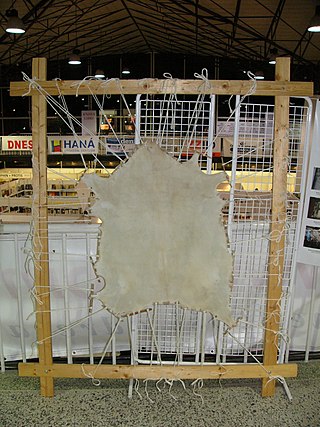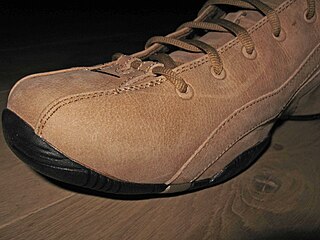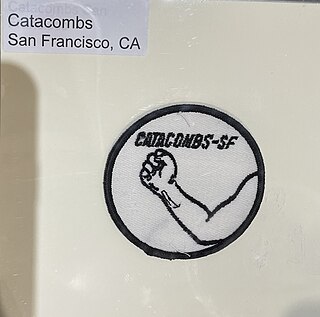Shiraro is a leather material that is wrapped around the waist.
In Tigriña, Shiraro is spelled Shirara and refers to a leather tunic decorated with small sea shells, usually worn by male farmers in the highlands.
Shiraro is a leather material that is wrapped around the waist.
In Tigriña, Shiraro is spelled Shirara and refers to a leather tunic decorated with small sea shells, usually worn by male farmers in the highlands.

Leather is a strong, flexible and durable material obtained from the tanning, or chemical treatment, of animal skins and hides to prevent decay. The most common leathers come from cattle, sheep, goats, equine animals, buffalo, pigs and hogs, and aquatic animals such as seals and alligators.

Leather subculture denotes practices and styles of dress organized around sexual activities that involve leather garments, such as leather jackets, vests, boots, chaps, harnesses, or other items. Wearing leather garments is one way that participants in this culture self-consciously distinguish themselves from mainstream sexual cultures. Many participants associate leather culture with BDSM practices and its many subcultures. For some, black leather clothing is an erotic fashion that expresses heightened masculinity or the appropriation of sexual power; love of motorcycles, motorcycle clubs and independence; and/or engagement in sexual kink or leather fetishism.

The Worshipful Company of Cordwainers is one of the Livery Companies of the City of London. Cordwainers were workers in fine leather; the Company gets its name from "cordwain" (cordovan), the white leather produced from goatskin in Cordova, Spain. All fine leather makers, including Girdlers and Glovers, were originally classified as cordwainers; however, the term eventually came to refer only to fine leather footwear, including boots.

Goatskin refers to the skin of a goat, which by long term usage, is denoted by the term Morocco leather. Kidskin, used for gloves, shoes and other accessories, is traditionally goatskin, although other leathers such as sheep and kangaroo can be used to make kid.

Nubuck is top-grain leather that has been sanded or buffed on the grain side, or outside, to give a slight nap of short protein fibers, producing a velvet-like surface. It is resistant to wear, and may be white or coloured.

Harry Irving Thayer was a member of the United States House of Representatives from Massachusetts. He was born in Pembroke on September 10, 1869. He attended the public schools of Hanover and engaged in the leather business. He was an organizer and president of the Thayer-Ross Co., president of the New England Shoe and Leather Association, and president of the Tanners’ Council of the United States. Thayer was a delegate to the Republican National Convention in 1924, and was elected as a Republican to the Sixty-ninth Congress. He served from March 4, 1925, until his death in Wakefield on March 10, 1926. His interment was in Lakeside Cemetery.
Napa leather is a leather noted for its soft feel, derived as it is from calves, lambs, and kid goats, which have soft hides. It is a generic term in the leather field and has no distinct test for characterization. Among other uses, napa leather is often used in leather products such as furniture, clothing, handbags, car seats, and shoes.
Hisam-ud-din Usta (1910–1987) was a popular artist born in the erstwhile Bikaner State. Hisam-ud-din was the last formally trained painter in the Bikaner School style/tradition and became a celebrated artisan in the media of Naqqashi and Manoti. Manoti is an embossed medium where gold is layered with painted floral patterns using translucent and opaque oil and watercolours on bronze, wood, gold, silver, plaster of paris, and camel leather. Naqqashi has the same methods as Manoti in its application but the gold is unembossed. These media are proprietary methods practiced only by Usta artisans of Bikaner.
Sheraro is a town and separate woreda in Tigray, Ethiopia. It is located in the North Western Zone of the Tigray Region, at an elevation of 1246 meters above sea level. It is the administrative center of Tahtay Adiyabo. It is near the border with Eritrea.

Calfskin or calf leather is a leather or membrane produced from the hide of a calf, or juvenile domestic cattle. Calfskin is particularly valuable because of its softness and fine grain, as well as durability. It is commonly used for high-quality clothing, shoes, wallets, and similar products, as well as traditional leather bookbindings. In these contexts, just "calf" is commonly used. Fine calfskin is one of the skins used for vellum and parchment manuscripts.

Las Ventas con Peña Aguilera is a municipality located in the province of Toledo, Castile-La Mancha, Spain. According to the 2006 census (INE), the municipality had a population of 1351 inhabitants. The municipality is located 35 km away from Toledo.

Hwa (Korean: 화) are a type of traditional Korean boot, which, along with 이; yi, is a subdivision of Korean shoes. The yi refers to all kind of shoes that do not go up to the ankle. Hwa are usually made of leather, and artisans who make the shoes are called 화장; hwajang. Hwa were originally worn by the Northern kingdoms of Korea. The horse-riding cultures of the North appear to have typically worn leather boots, while the farmers of the South wore shoes of leather or straw. Different types of boots were worn by military and civil officials.

Marocchino is a coffee drink created in Alessandria, Italy.

Hell Bent for Leather is a 1960 American CinemaScope Western film directed by George Sherman and starring Audie Murphy, Felicia Farr, Stephen McNally and Robert Middleton. The film was based on the 1959 novel Outlaw Marshal by Ray Hogan and filmed on location in the Alabama Hills of Lone Pine, California.

Folsom Street is a street in San Francisco which begins perpendicular to Alemany Boulevard in San Francisco's Bernal Heights district and ends perpendicular to the Embarcadero on the San Francisco Bay. For its southern half, Folsom Street runs north–south, but it turns northeasterly at 13th street. It runs through San Francisco's Bernal Heights district, Mission District, SoMa District, Yerba Buena District, and South Beach district.

The Catacombs was a gay and lesbian S/M leather fisting club in the South of Market area of San Francisco, which operated from 1975 to 1981, and reopened at another location from 1982 to 1984. It was the most famous fisting club in the world. The founder and owner was Steve McEachern. The location was semi-secret and admission was by referral only. It was originally a gay men's club, but Cynthia Slater persuaded the management to open up to lesbians. Among the patrons was Patrick Califia, known then as Pat Califia. The Catacombs has been exhaustively described by sexual anthropologist Gayle Rubin, who calls it "exemplary" in its attempts to deal with the AIDS crisis which would eventually lead to its closure. Patrick Moore devotes a chapter to it in his Beyond Shame: Reclaiming the Abandoned History of Radical Gay Sexuality. Sex educator Carol Queen called it "the place to be seen and to play at during the 1980s."

Mamuang kuan, also referred to as preserved mango or mango leather, is a traditional Thai sweet. It is a preparation of dried mango in fruit leather form. Mamuang kuan's shape is slender and delicate, its texture is chewy, and its color is gold. People sometimes make the sweet into a circle, flower, or spiral.

The Leather Bottle is a pub at 538 Garratt Lane, Earlsfield, London SW17.
Leather Stocking is a 1909 American silent short drama film directed by D. W. Griffith, adapted from James Fenimore Cooper's 1826 novel The Last of the Mohicans.

San Francisco Eagle is a gay bar in San Francisco's South of Market neighborhood, in the U.S. state of California. The bar caters to the bear community and the leather subculture. Lex Montiel is one of the bar's owners, as of 2018.